
|

|
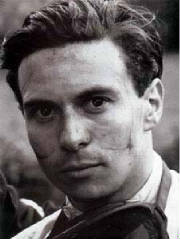
Jim Clark
Jim Clark born March 4th 1936 was a Scottish Formula One racing driver considered one of the best drivers in motor sport
history. He was born into a farming family in Chirnside, Berwickshire, Scotland, a small village outside of Duns. The youngest
child and only boy. He was educated at Loretto School in Edinburgh.
Although his parents were opposed to the idea, Clark started his racing career driving in local road rallies and hill
climb events driving his own Sunbeam Talbot, and proved to be a fearsome competitor right from the off. By 1958 Clark was
racing for the local Border Reivers team, racing Jaguar D-Types and Porsches in national events, and winning 18 races.
Then on Boxing Day 1958, Clark met the man who would launch him to superstardom. Driving a Lotus Elite, he finished second
to Colin Chapman. Chapman was sufficiently impressed to give Clark a run in one of his Formula Junior cars, and the rest,
as they say is history.
After Aston Martin's F1 programme fell through, Clark was a free agent. Colin Chapman snapped him up for his F1 squad,
and Clark made his debut in the 1960 Dutch Grand Prix. Throughout his F1 career from 1960 to 1968 Clark drove only for the
Lotus team. He developed a near telepathic relationship with Chapman, which contributed to their outstanding success together.
Chapman's innovative and nimble designs combined with Clark's skills at the wheel made for a nearly unbeatable force. 1962
saw Clark battling Graham Hill who drove for BRM for the World Championship in Chapman's brilliant Lotus 25, but in the final
race an oil leak caused him to drop out just as victory seemed a formality.
His first Drivers' World Championship came driving the Lotus 25 in 1963, winning seven out of the ten races and Lotus
its first Constructors' World Championship. In 1964 Clark came within just a few laps of retaining his crown, but just as
in 1962, an oil leak from the engine robbed him of the title, this time conceding to John Surtees. He made amends and won
the Championship again in 1965 and also the Indianapolis 500 in the Lotus 38. He had to miss the prestigious Monaco Grand
Prix in order to compete at Indianapolis, but made history by driving the first mid-engined car to win at the fabled "Brickyard,"
as well as becoming the only driver to date to win both that race and the F1 title in the same year.
At the same time, Clark was competing in the Australasia based Tasman series, run for older F1 cars, and was series champion
in 1965, 1967 and 1968 driving for Lotus. He won 14 races in all, a record for the series.
The FIA decreed from 1966, new 3-litre engine regulations would come into force. Lotus were less competitive. Starting
with a 2-litre Coventry-Climax engine in the Lotus 33, Clark did not score points until the British Grand Prix and a third-place
at the following Dutch Grand Prix. From the Italian Grand Prix onward Lotus used the more complex BRM H16 engine in the Lotus-BRM
43 car, with which Clark won the United States Grand Prix.
During 1967 Lotus and Clark began their fruitful association with Ford-Cosworth. Their first car, the Lotus 49 featuring
the most successful F1 engine in history, the Ford-Cosworth DFV, which won its first race at the Dutch Grand Prix, driven
by Clark. He won with it again at the British, United States and Mexican Grands Prix and, in 1968, at the South African Grand
Prix. He had established himself as the dominant driver in the dominant car.
On April 7 1968, however, Jim Clark's life and driving career was brought to a premature and tragic end when, during a
Formula 2 race, his Lotus 48 veered off the Hockenheimring, Germany and crashed into trees. The cause of the crash was never
definitively identified, but investigators concluded it was most likely due to a deflating rear tyre. The 1968 F1 Drivers'
Championship was subsequently won by his Lotus team-mate Graham Hill.
Clark achieved 33 pole positions and won 25 races from his 72 Grands Prix starts. He is remembered for his ability to
drive and win in all types of cars and series, including a Lotus-Cortina, with which he won the 1964 British Touring Car Championship,
IndyCar, NASCAR, driving a Ford Galaxie for the Holman Moody team, Rallying, where he took part in the 1966 RAC Rally of Great
Britain in a Lotus Cortina, and nearly won the event before crashing, and sports cars. He competed in the Le Mans 24 Hour
race in 1959, 1960 and 1961, finishing 2nd in class in 1959 driving a Lotus Elite, and finishing 3rd overall in 1960, driving
an Aston Martin DBR1. He was also able to master difficult Lotus sportscar prototypes such as the Lotus 30 and 40.
Clark had an uncanny ability to adapt to whichever car he was driving. Whilst other drivers would struggle to find a good
car setup, Clark would usually set competitive lap times with whatever setup was provided and ask for the car to be left as
it was. A shy and undemonstrative man, he apparently had difficulty understanding why other drivers were not as quick as himself.
Jim Clark is buried in the village of Chirnside in Berwickshire.

Graham Hill
Norman Graham Hill was born February 15th 1929 in London. An extremely determined and intelligent man, Hill was nonetheless
one of the most larger than life characters F1 has ever seen, with a quick sense of humour. He didn't even pass his driving
test until he was 24, and his first car was a wreck. He later said 'A budding racing driver should own such a car, as it teaches
delicacy, poise and anticipation, mostly the latter I think!'
He met Colin Chapman after driving a few laps of the Brands Hatch circuit, and hitched a ride back to London with the
Lotus boss. After Colin agreed to pay him as a mechanic, to the tune of £1 a day, Graham talked his way into a works Lotus
drive.
He later left to join BRM, much to Chapman's annoyance. After winning the 1962 world championship for BRM, Hill was always
in the hunt for the title. He was famously launched out of the race at the final race of the 1964 season by John Surtees'
team mate, Lorenzo Bandini, costing him the world championship to Surtess. In response to this, Hill sent Bandini a 'Learn
To Drive' manual for Christmas that year.
Hill won the Indianapolis 500 in 1966, the second Briton to do so in two years before he returned to Lotus for 1967 season
after BRM became uncompetitive. After Jim Clark's tragic death, Graham took over as team leader, pulled the heartbroken team
together and won the world championship again at the end of the year. After being paired with Rindt for 1969, Hill started
the year well and won his fifth Monaco Grand Prix victory, a record that stood for 24 years until Ayrton Senna won the race
6 times. Graham then lost pace towards the end of the year. The situation wasn't helped by a massive leg breaking accident
at the end of the season in the USA Grand Prix.
After his recovery, he concentrated mostly on sports cars, and won the Le Mans 24 Hour race in 1972, becoming the only
driver to win the 'Triple Crown of Motorsports.'
Hill set up his own racing team, Embassy Hill Racing but this ended in tragedy as Hill, his driver Tony Brise and three
members of the team were killed on 29th November 1975 while flying back froma test session at Paul Ricard. It was the end
of an era.
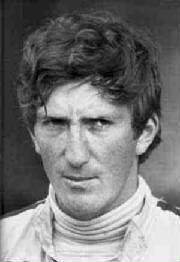
Jochen Rindt
Karl Jochen Rindt was born 18 April 1942 to Austrian and German parents. His parents were killed in an allied bombing
raid, and he was brought up by his grandparents in Graz, Austria.
A spectacularly fast driver, Rindt seemed in his early F1 career, to be in the wrong car at the wrong time. From 1964
to 1968, Jochen was a regular points scorer-when his car held together. It was only a move to Lotus in 1968 replacing Jim
Clark that he became a consistent competitor.
Rindt preferred a stable mechanical environment, so wasn't very comfortable in one of Colin Chapman's cars. This lead
to a rather fractious relationship between the two men, but when the car was working, Rindt proved to be more than a match
for anyone else. He took his first win at the US Grand Prix in 1969, before starting 1970 as the title favourite. He used
the Lotus 49 to score a memorable win in Monaco, before Chapman gave him the excellent Lotus 72.
After winning 4 races on the trot, Jochen seemed assured of the championship, until practice for the Italian Grand Prix.
Rindt wanted to use the Lotus 49, as he felt the Lotus 72 with it's integral wings removed was far too dangerous. Chapman
told him the 49 wasn't available and the 72 would have to do. Reluctantly, Jochen took to the track.
On the fastest part of the track, the 72's brakes failed. Jochen didn't stand a chance and was slammed into the guard
rails at almost full speed. He was killed instantly. Some irony came from the fact that the Lotus 72 won the Italian Grand
Prix at the same circuit two years later with it's wings in place.
Chapman was devastated and he withdrew the team from the race, but Jochen's points total so far proved insurmountable
for Jacky Ickx in the Ferrari and Rindt was the sport's only posthumous world champion. It was especially sad, as Jochen had
promised his wife Nina that he'd retire from the sport at the end of the year if he won the title.
|

|

|

|

|

|
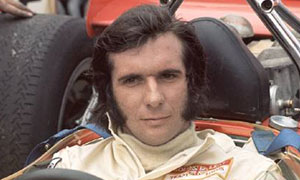
Emerson Fittipaldi
Emerson Fittipaldi was born 12th December 1946 in Sao Paulo, Brazil, the son of a motor racing journalist. He and his
older brother Wilson started off racing motorbikes before a switch to cars in the late 1960's. After winning the British Formula
Three championship for Lotus, Colin Chapman snapped up Fittipaldi for his F1 team for 1970. He made his debut at the German
Grand Prix and took over as team leader when Jochen Rindt was killed in Italy.
Emmo's first win came at the US Grand Prix, which helped Rindt become F1's only posthumous world champion. The Lotus 72
was updated during 1971, and Emerson used the car in 1972 to become the youngest F1 world champion with five wins. He was
joined by Ronnie Peterson for 1973. The two drivers fought a good natured internal battle during the season but their in-fighting
helped Jackie Stewart retake the title that season. Fittipaldi and Peterson's combined points were more than enough for Lotus
to retain the constructors' title.
Emerson then moved on to McLaren for 1974 and won the championship back, before giving best to Niki Lauda in 1975. Then
he made a daring and ultimately wrong move to join his brother's Copersucar racing team for 1976. Emerson struggled on for
four years before announcing his retirement from F1 at the end of 1980.
He took up competition in America and won the 1989 Indycar championship and the 1993 Indy 500. However a back injury during
1996 ended his racing career, and he is now a commentator in his native Brazil.

Ronnie Peterson
Bengt Ronnie Peterson was born in Orebro, Sweden on 14th February 1944. Froma young age he was totally obsessed with
cars and speed. After a successful karting career, Ronnie enterd his first F1 race at Monaco in 1970, whilst simultaneously
competing in F2. He won the F2 title in 1971, and finished second to Jackie Stewart in the F1 driver standings driving the
odd tea tray nosed March.
It was his move to Lotus in 1973 when Peterson really came of age. He and the Lotus 72 were a perfect match, and he took
four wins that season. His amazing car control and blinding speed were a perfect match for the 72's strongest points. The
sight of the 72 sidways coming out of corners became Ronnie's most enduring image in most people's minds.
Two more years at Lotus gave him another 3 wins, before he moved back to March for 1976, an then to Tyrrell to drive the
six wheeled P34. Neither car or team really suited Peterson and a single win and a handful of podium places were his reward,
before he moved back to Lotus for 1978 with Mario Andretti.
Mario and Ronnie hit it off immediately and became very close friends. The two dominated 1978 in the Lotus 79, with Ronnie
picking up two more excellent wins. It was clear one or the other Lotus driver would take the title, and at Monza it was between
the two.
In practice, Ronnie had damaged his Lotus 79, so had to start in the old 78. The start was bodged and Peterson was caught
up in a huge accident at the first corner. His car was pushed nose first into the barriers, breaking his legs before the Lotus
burst into flames. James Hunt pulled him from his car, and at first Ronnie seemed to have escaped injury. Sadly he was to
die that night from blood clots. He was the fastest man in F1 throughout the mid 70's and well liked and respected by the
other drivers.
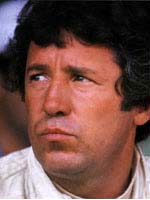
Mario Andretti
Mario Gabriele Andretti was born on 28th February in Montona in Italy. When he was young, his family was moved into a
displaced persons camp in Trieste. They eventually left at the end of hostilities in 1945. Mario grew up surrounded by cars,
and he and his brother, Aldo enjoyed attending motor races. Mario's heroes were Fangio, Moss and Alberto Ascari. Mario decided
he wanted to be a racing driver then and there.
His family emigrated to America, and settled in Nazareth, Pennsylvania, where they live today. Mario first tried his hand
at midget racing, dirt track and dragsters and proved to be a very promising driver.
So promising in fact that an Indycar talent scout noticed him and offered him an Indycar drive. He accepted, and became
the first rookie ever to win the Indycar title in 1965. He entered the Indianapolis 500, and won in 1969. He also won the
Daytona 500, and a NASCAR title. Andretti became interested in Sports Car racing, and from there, F1, where he debuted for
Lotus in 1968. In 1971, he won his first GP for Ferrari.
In 1976, he accepted a full time drive with Lotus, and declared that years' car to be a dog. But Lotus boss, the brilliant
Colin Chapman, had a special car in the pipeline. The 1977 Lotus was a 'wing car', the idea being to reduce the air pressure
under the car, sucking the car onto the road with more force than conventional wings. Andretti won several times, but unreliability
kept him from the title, but in 1978, he had no such bad luck.
The Lotus 79 was the most beautiful F1 car ever. It was also the fastest car on the track that year, and nothing could
be done to beat it, unless you had the Brabham 'fan car', which was banned after just one race anyway..... Andretti won seven
times, and his team mate Ronnie Peterson won twice.
Mario clinched the championship at Monza, in Italy, but in tragic circumstances. Peterson had crashed his car in practice,
so had to start in the 1977 car. There was a huge accident at the beginning of the race, which Peterson was involved in. Ronnie
was taken to hospital, and died the following morning, from the effects of injuries to his legs that he suffered in the crash.
Mario was devestated, and was never the same driver again.
He returned to the USA in the early 80's, to continue his US career. He was successful, but concentrated on trying to
win the Le Mans 24 Hour race, something which he has yet to achieve, but knowing Mario Andretti, he won't give up until he
has won it!
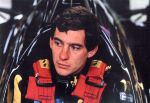
Ayrton Senna
Ayrton Senna Da Silva was born on 21st March 1960, in Sau Paulo, Brazil. His father was a wealthy industrialist, and gave
Ayrton a kart when he was 4. Ayrton took racing very seriously, always practising, and training in any weather. In 1980, Senna
moved to Britain, to further his career, but despite great success in FF1600, he didn't get the backing or support he needed
and went home, down hearted. But he came back at his father's urging, even more determined to succeed.
He won the 1983 Formula 3 championship by a long way, and the following year, moved into F1, with Toleman, for whom some
great performances-particularly at a wet Monaco-got him noticed by the bigger teams. For 1985 he joined Lotus. The team hadn;t
won a race for 3 years, but Ayrton took a dominant victory at a soaking wet Portugal. The Lotus cars were fast but unreliable
and a further 5 wins in 3 seasons weren't enough for Senna. He wanted a team that could win him the world championship and
in 1988 he left and joined McLaren. In 1988, the McLaren team were virtually unbeatable, and won 15 out of 16 races, with
Senna the champion, and his team mate, Alain Prost, second.
But the storm clouds were brewing between the two drivers. In 1989, Senna won six times, but Prost cleverly racked up
the points, and was ahead at the Japanese GP. Senna wanted to win even more than Prost, and tried to overtake him at the final
corner, but Prost saw him coming, and turned in on Senna, taking Senna out of the race, and making Prost the champion. Senna
was NOT amused.....
The following year, Prost was at Ferrari, and this time Senna had the advantage over Prost. Again at Japan, for the second
year running, the sparks really flew.
Senna had claimed pole position, but Prost had been given the cleaner side of the track, with better getaway chances.
This fired Senna up even more..... At the green light, Prost led away, but Senna took no chances and at the first corner of
the first lap, aimed the nose of the McLaren at the rear of the Ferrari. The two cars smashed into each other, taking Prost
out, and making Senna the champion.
The following year, Senna won his final championship, beating Nigel Mansell, but after that the McLaren was off the pace.
In 1992, the Williams of Nigel Mansell stomped all over the opposition, making Nigel the champion by over 50 points. This
didn't stop Senna holding off Mnsell to win a brilliant Monaco GP, but in 1993, the McLaren had an underpowered engine, and
Prost was back-in Mansell's place at Williams.
At the European GP at Donington Park, the weather was awful on race day. Senna was in fourth place on the grid, but his
skill in the wet, and his refusal to give up meant he passed three cars in one lap, and started lap 2 in the lead of the race!
It was his greatest drive, and surely one of the most remarkable races in GP history.
In 1994, Senna at last joined Williams, but was off the pace in the first two races. At San Marino, he was leading, when
a technical faliure caused his car to go straight on at a fast corner. He hit the wall, and was killed instantly. Possibly
the greatest driver of all time was dead, and F1 has never been the same without him.
|

|

|

